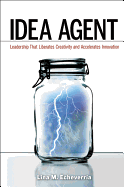
Lina M. Echeverria. Idea Agent: Leadership That Liberates Creativity and Accelerates Innovation. New York: American Management Association, 2013.
I need to be up front about something before commenting on this book. It was recommended to me by two friends of mine who indicated the author was a friend of theirs. I did not anticipate that they would be highlighted in the Acknowledgements as inspiration and support for the book being written. Having said that, I want to assure the reader that the following presentation recognizes the strengths and weaknesses of this book.
First, the primary strength is that the author has provided us with an autobiographical account of her highly successful role in managing and leading fast paced high innovation project teams and R&D activities in a large corporation. As Charles O’Reilly says in the Foreword, “Lina is first a world renowned engineer and scientist with a Ph.D. in geology and over thirty years of experience as both a scientist and a senior manager at Corning…” She rose to become Vice President for Science and Technology.
Second, the author draws on this wealth of experience to organize and present a wealth of learning about what is required to manage and lead teams and organizations involved in both creativity and innovation. One construct is her “Seven Passions of Innovation” that must be attended to in fostering individual, team and organizational engagement in the creative and innovation processes:
- Looking at creative conflict in the eyes and flexing for resolution
- Bringing together teams of diverse, highly intelligent people freely in a way that engages their deepest personal motivations
- Living values that set creativity free
- Insisting on excellence and results
- Cultivating a culture that honors time for intuitive flow
- Defining an organizational structure that guides, but allow solutions to9 come from many permutations of talent and function
- Providing authentic leadership with the will to manage, the guts to decide, the wisdom to guide, and the passion to make innovation happen
Take a close look at this list with an integral lens and you will find every quadrant addressed and consideration for some lines of development. While other elements of the integral perspective may not be addressed I would suggest that in the rich stories the author tells of her experiences some will be found.
Also, implicit in this list is the setting up polarities, held in tension in the process of innovation, e.g. values related to creativity on the one hand and structure and results on the other. This points to another strength of this book, namely the emphasis placed on values and culture.
Note her treatment of the seven passions:
The Seven Passions are neither a recipe to be followed with specific ingredients added in sequence, but rather an approach and a philosophy meant as motivation and inspiration for every leader to create a culture where innovation thrives.
This book inspires and it is problematic, as well. Because it is filled with the authors sense of what should happen in organizations her many recommendations are challenging to implement. As Argyris (Flawed Advice and the Management Trap) would say, it is not actionable. In this case that means that there is much for individuals and organizations to experiment with and getting it “right” for individuals and organization is no easy task.
A second problem arises from the very culture of leadership the author has thrive in: there is no meaningful distinction between managing and leading. I will not belabor this.
Finally, some of the recommendations do not engage issues raised by the recommendations, themselves. An example is the emphasis put on having clear roles. I suspect the author would agree that not only is this challenging to achieve, but it is a moving target. Role ambiguity, role conflict and the like are endemic to human systems. Treating roles as evolving, shifting, moving sets of expectations is a far richer and deeper approach than simply saying that having clear roles is important.
Despite these considerations, I found this book to be a rewarding and inspiring presentation of learning from an amazing career. This is not a book about a CEO. It is a book about an individual who occupied numerous roles, including a manager role, who also demonstrated her ability to lead effectively.
